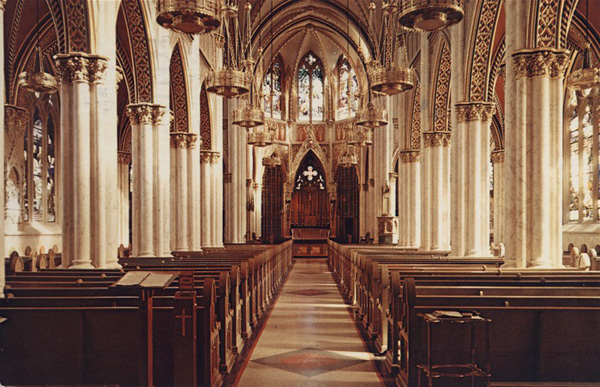Congregation and Audience: Accepting Truth through Practice
On page 296, Rose contends "Audience studies focuses
most strongly on the site of audiencing in its social modality." She further
discusses the benefits of these studies stating, "[They] can explore the richness and
complexity of audience's engagements with visual materials while paying attention to
social power relations." Thus, Rose acknowledges the social benefits of studying
people in environments which are essentially considered culturally normal and/or safe.
That is to say that every celebration of the Eucharist, every prayer, every act of
reverence, every normalized practice associated with the Catholic Church during this
time of worship, unless deemed by an individual who holds a higher position in the
hierarchy or priesthood, always remains constant. It is this continually employed
precept of security through practice which is capable of both cultivating and
solidifying Catholic beliefs of what is true, for in the ever changing world, patrons
will always make the sign of the cross, genuflect before entering their pew, christen
their foreheads with holy water and repeat the same prayers and responses in unison.
All in all, mass will always remain the same.
Through this unspoken yet understood promise of safety, the Church once again attempts to
establish a sense of truth and further present it to the congregation as a contention to
their audience claiming that through their abilities to maintain and deliver a traditional
mass on a weekly basis, they in fact have the power to conserve a sense of peace within
God's house. This stabilization and further preservation of practice and tradition
fulfills those ideologies of that which is believed to be true. Jennifer A. Scott's article
Our Callings, Our Selves: Repositioning Religious and Entrepreneurial Discourses in Career
Theory and Practice highlights the dangers in the potentially false sense of security and
desire presented by religious institutions. Scott examines the metaphor of "the call"
which often times summons individuals into a religious discourse and on occasion, begs
their life long devotion. In regards to her study Scott asserts, "By incorporating the
integrative concept of discursive positioning, this study alerts us to a more nuanced
understanding of the tensions and contradictions that arise in and through calling
narratives." (261). Thus, as these narratives are perceived as true, they become cultural
fictions, or rather traditions, and develop the power to withstand the test of time.
This illustration therefore exhibits the idea that within these areas where individuals
may feel most comfortable and secure they potentially may submit to a higher institutional
power where a mere idea or fleeting thought has the potential to be transformed into
dogma. This situation in itself raises a question of agency in that it reverts a sense of
accountability back upon the individual. In his article Developing a Critical Discourse:
Michel Foucault and the Cult of Solidarity, Hearn references Foucault's stress on power
relationships as they relate to solidarity. Hearn applies Foucault's view on ethics, which
he states are "based in the notion of care of the self…" Furthermore, this care of the
self can "only be reinvigorated by applying the Socratic ideal of self-examination and
self-transformation" which, as it relates to the congregation, imposes a sense of agency
upon parishioners (Hearn 21).
Therefore as depicted in both the various apparatuses and technologies of the Catholic
Church, along with an audience which highlighted some of the normalized practices within
the Catholic faith, it is evident that the call into a culture by historical institutions
is one which can be misguided I belief and veiled deceit due to its previously established
historical validity. While the Catholic Church has stood steadfast in tradition and
passionate in belief, the culture of judgment which it has created among its parishioners
is one initiated by fear of a being bigger than any society could imagine. Thus, the
Church attempts to feed its congregation truth through normalized practices and accepted
beliefs instead of allowing and expecting their followers to set their own standards of
morality and govern themselves instead of each other.

|
|
As it relates to the Catholic Church, multiple aspects
from its architecture, the progression of the mass, to the symbolism of each
individual, both priest and patron, represent some sort of governmentality within the
institution. That is to say that the church itself provides a particular discourse in
which Catholics, some more devout than others, attempt to appeal to the better nature
of an all seeing God. If we take into consideration the architectural/spatial aspects
of a Catholic Church, we can note the presentation, and rather separation between the
priest and his congregation simply because the priest, along with other leaders, such
as the deacon, can be located at the front of the church closest to Jesus Christ. This
distance creates and further symbolizes each individual's place, or rather role,
within the church - some are made to feel big, while others are made to feel small. In
relation to Rose and Foucault, the Catholic church doesn't necessarily represent a
regime of punishment, but rather a regime of judgement. Its production of Catholics,
all of whom are being "watched" by the head of the church, the saints, each other and
above all the spiritual representation of Jesus Christ, somewhat brings Foucault's
theory of panopticon to a new level in the sense that the material aspect of the
representation of fear is removed and instead replaced by the fervent belief that
someone else is in charge. Thus, through this somewhat "invisible" sense of
panopticon, in combination with an overwhelming sense of governmentality, the church's
production of Catholics provides a vivid illustration of the ways in which an
institution calls its subjects into existence, formulating practices which are
considered the norm, and even more so bestowing an overwhelming sense of significance
upon the objects and their symbolism within the church.
Works Cited

